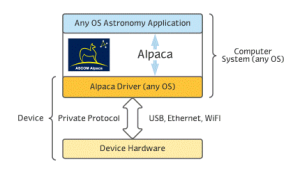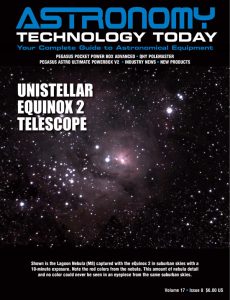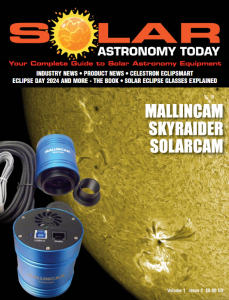The ASCOM Alpaca Initiative has created a new, nontechnical website that is meant to provide public outreach to help generate awareness and interest in Alpaca and ASCOM Universal APIs for astronomical devices. The ASCOM Alpaca Initiative was created in 2018 to provide a compatible universal interface, which runs on any system including embedded processors. The ASCOM Initiative is 100% volunteer based and provides technology and support pro bono.
As the team notes about the platform’s new website, “It is non-technical, focusing on the fact that ASCOM Alpaca Initiative is designed to overcome two common problem areas with astronomy connectivity: (1) USB, the number one source of pain in astronomy, and (2) Classic ASCOM drivers. While an Alpaca device can have a separate driver, the long-term goal is for devices to have the Alpaca interface built-in and providing the network API to apps directly with no driver or USB, thus being driverless and USB-less.”
ASCOM Alpaca is a modern standard that offers functionality that is being adopted by a number of companies within the amateur astronomy industry. ASCOM Alpaca provides communication between astronomy programs and astronomy devices on multiple operating systems like iOS, Linux, Android, and Mac, using the Internet (which means Wi-Fi-connected mobile devices and also astronomy instruments connected via Wi-Fi). It also provides transparent communications with existing unmodified devices, drivers and programs on Windows. Alpaca can be integrated into devices including mounts, cameras, dome & roof controllers, weather sensors, focusers, and filter wheels.
Since Alpaca can be built into a device, the device itself speaks a universal protocol that can be directly understood by any program. Everything needed is part of the device. This eliminates the need for additional drivers and support platforms.
As the team notes, “Your current Windows-hosted astronomy programs now have an “on-ramp” enabling them to use Alpaca devices. The ASCOM Chooser can automatically discover Alpaca devices and provide the connection enabling your apps to use them, all without requiring any change to your programs. 100% Compatible. And Windows ASCOM devices now have an “on-ramp” to Alpaca ASCOM Remote, a simple Windows app, turns your Windows ASCOM devices into Alpaca devices that can be controlled from a separate PC via your local net or by programs like SkySafari 7 and Cartes du Ciel.”

The two diagrams offered in Images 1 and 2 show the most common connectivity patterns when using Alpaca. In Image 1, the astronomy app includes the Alpaca network protocol, as does the adapter/driver. The “network” in this case connects two programs running on the same box but still using TCP/IP and other common layers. Both reside on the same physical computer, similar to how apps and devices relate on Windows systems with COM, but here we may be on a box running any OS.
In Image 2, the astronomy app also includes the Alpaca network protocol, but the driver is within a self-contained device. An example would be a mount with embedded Raspberry Pi controlling the motors and the hand box, but also including a tiny server that provides Alpaca access.
The ASCOM Alpaca Initiative provides the path for:
– Astronomy programs and devices to be connected across Windows, Linux, and Mac OS.

– Observatory systems to include programs and devices on multiple platforms.
– Devices that can operate via Wi-Fi or Ethernet and avoid the problems with USB.
– Interoperability between astronomy programs and devices running under different operating systems.
– Implementation of astronomy programs and device control logic written in different languages on different operating systems.
– Current unmodified Windows astronomy programs to use ASCOM compatible devices connected to any networked PC or other platform via Alpaca, or a self-contained Alpaca device.
– Current unmodified Windows-resident devices (mounts, focusers, etc.) to be used by astronomy programs running on networked PCs, Macs, and mobile devices that use Alpaca for device communications.
You can learn more about the ASCOM Alpaca Initiative here.

 And to make it easier for you to get the most extensive news, articles and reviews that are only available in the magazine pages of Astronomy Technology Today, we are offering a 1-year magazine subscription for only $6! Or, for an even better deal, we are offering 2 years for only $9. Click here to get these deals which only will be available for a very limited time. You can also check out a free sample issue here.
And to make it easier for you to get the most extensive news, articles and reviews that are only available in the magazine pages of Astronomy Technology Today, we are offering a 1-year magazine subscription for only $6! Or, for an even better deal, we are offering 2 years for only $9. Click here to get these deals which only will be available for a very limited time. You can also check out a free sample issue here.
The Sun is more active than it’s been in years and if that’s not enough, we have the upcoming Total Solar Eclipse on April 8, 2024! If you’d like to learn more about the technology behind solar observing, solar imaging and more, you can check out our new monthly magazine – Solar Astronomy Today. It’s free to read, no subscription needed and available here. And if you are preparing for the upcoming eclipses and want to know your equipment options from solar glasses to the most out of this world solar viewing and imaging options, check out our free publication – The Definitive Guide to Viewing and Imaging the Sun – simply click here and enjoy reading!

